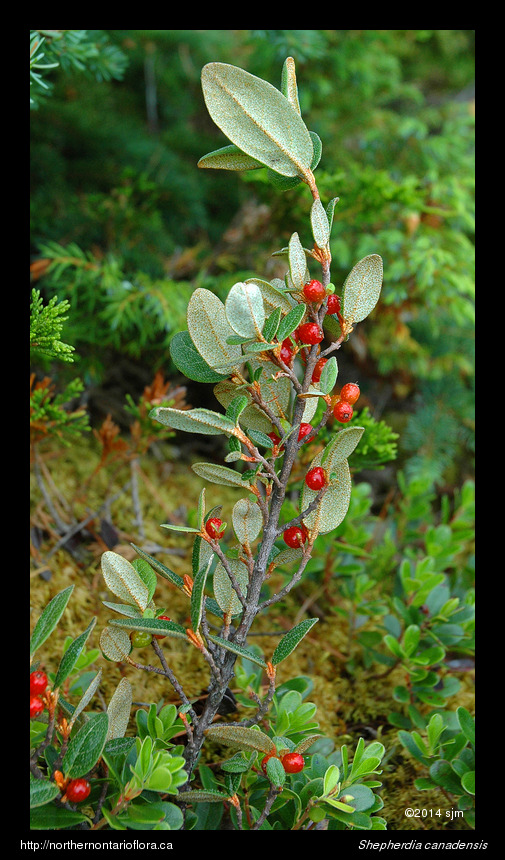
|
Northern Ontario Plant Database 
Plant DescriptionShepherdia canadensis (L.) Nutt.En: soapberry, Canada buffaloberry, russet buffaloberry, soopolallie, rabbit berry
Elaeagnaceae (Oleaster Family) General: An open deciduous shrub, 0.3—2 m tall; usually less than 1 m tall in our area. Stems/twigs: Young twigs and buds are rough-textured (scurfy), with a dense cover of overlapping rusty-brown peltate scales over a layer of white star-shaped (stellate) hairs. Vegetative buds are stalked and naked, the two valvate scales are ovate to oval and flat, while flower buds are globose and axillary or clustered at the tips of short lateral branches. Older branches are grayish-brown to dark brown. Leaves: Opposite and simple; petioles are about 1 cm long. Leaf blades are elliptic, oblong, to ovate, 3—5 cm long by 0.5—3 cm wide, leathery-textured (coriaceous), dark green above with scattered white stellate hairs; the lower leaf surface is densely coated with both stellate hairs and scattered rusty-brown scales. Leaf bases and apices are rounded to blunt (obtuse); margins are entire and slightly turned under (revolute). Flowers: Unisexual, with male and female flowers borne on different shrubs (dioecious). Flowers small, about 3—5 mm across; both male and female flowers have a greenish-yellow 4-lobed calyx with pointed lobes that are spreading or bent backward (reflexed); petals are lacking. Male flowers, borne in clusters on short lateral branches, have 8 stamens that extend above the calyx and alternate with 8 small ovoid yellow nectaries that form a ring at the base of the calyx; female flowers are borne singly in the axils of lateral leaves and have a pistil with an inferior ovary topped by a short style. Flowers bloom in spring, before the leaves emerge. Fruit: A bright red oval berry-like fruit, 6—8 mm long, translucent, and dotted with white stellate hairs. The ripe fruit are bitter and contain compounds called saponins, which give the fruit a soapy texture. Fruits mature in mid to late summer. First Nations people in the Pacific Northwest use the soapberry fruit to make an ice-cream like desert (sxusem); the fruit are crushed and whipped with water and sugar (or sweet berries) to produce the frothy edible dessert. Habitat and Range: Dry basic soils, usually over limestone (calcareous) bedrock, or along shorelines with basic rocks (e.g., basalt) or basic sediments. Soapberry is native to North America and occurs in all Provinces of Canada. It is found throughout Ontario; in the Algoma District, it is most commonly found on St. Joseph Island and along the rocky coastline of Lake Superior. Similar Species: The related silverberry or wolf-willow (Elaeagnus commutata Bernh. ex Rydb.) has a range that extends from the north coast of Lake Superior to the shores of James Bay and Hudson Bay. It differs from soapberry by its oval to obovate leaves and ovoid opaque fruit, which are pale green and covered in silvery scales. Back to species list |
||||||||||||||||||||||






















